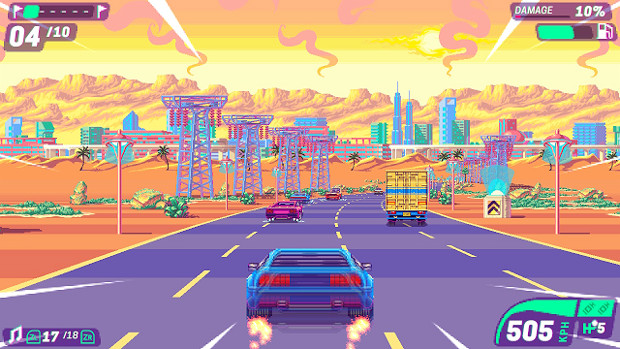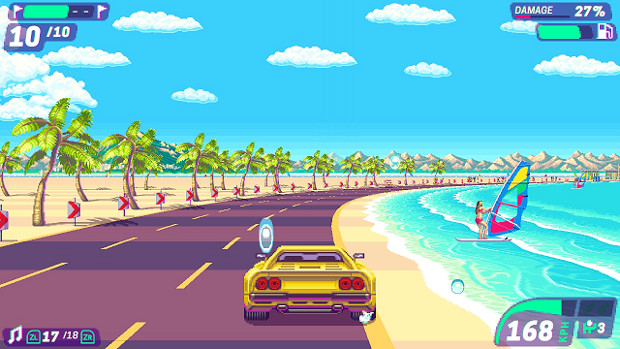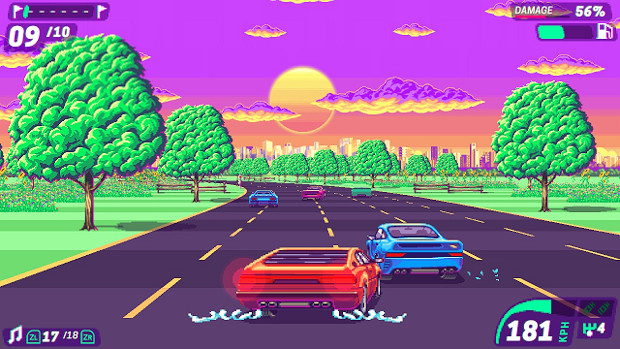Review: 80's Overdrive

Posted 20 May 2020 at 20:04 by Nick Lone
The classic arcade racer has seen somewhat of a resurgence on the Switch, and 80s Overdrive is looking to latch on to that trend.
With gameplay elements and visuals reminiscent of Sega’s Outrun, 80s Overdrive is a disappointing port of a 2017 3DS game which fails to capture much of the magic of its inspiration.
Unfortunately, the game is broken. I have been unable to complete a single run of the Time Attack mode because the game simply crashes at frequent intervals. The most I’ve managed in three attempts is 4:30 on the clock. The problem is less pronounced in Career Mode due to the shorter races, but how such a glaring issue was missed by QA is baffling. This is not the only issue, however. A couple of the stages in the game suffer from extremely noticeable slowdown. Despite its pixel art retro-inspired visual design, it seems optimisation has simply been skipped, in an attempt to rush it out the door.
From a visual standpoint, the game does capture the look of the era well. The parallax scrolling in the backgrounds brings back some great memories, and the bright and varied locales are pleasant to cruise through. The soundtrack, compiled of 80s-inspired synth and rock compositions, has a few standouts. 80s Overdrive certainly manages to emulate the mood quite well. That is, until you get to the forest stage, where the chuggy memories of underpowered hardware smack you back into reality. Inexcusable in 2020 for a 16-bit pixel art game on modern hardware.
 You should be able to get past that the gap between the car and truck in front without too much... oh.
You should be able to get past that the gap between the car and truck in front without too much... oh.
The two modes in the game are diametrically opposed. In Career Mode, you’re tasked with avoiding traffic and winning races across a number of tracks which vary in location and in length. In Time Attack, you’re forced to race through a number of continuous areas back-to-back, Outrun style, with checkpoints placed a minute or so apart. In this mode, passing close by other vehicles will give you a small time increase, which is vital in extending your time as you try to get on to the second, third and fourth area. While this is an interesting mechanic, the poor handling adds far too much risk for it to be a viable or competent strategy.
Enter problem number three. The handling is simply not responsive or precise enough to increase your time with any sort of ease. Light taps of the analogue stick or the D-pad are often unresponsive, requiring a heftier input, and lining up next to another car is simply a chore, which more often than not, results in a crash. A crash stops you dead. Getting back up to speed (I’m using manual transmission) seems to take forever and shifting through gears is also hit-or-miss when it comes to the response of the R button.
Competing in a number of one-off races, the Career Mode sees you trying to reach the top of the leaderboard from the bottom rung of the ladder. You start off with a small wad of cash, which is used to purchase your first car and enter your first race. The higher you place in each race, the more cash you receive to spend on upgrades, fix your damage or buy fuel and nitros. This system is well implemented, and there is quite a bit of tinkering around you can do. The fact that fuel loss and damage accumulate over each race means you constantly have to keep your eye on them and can’t go crazy spending on upgrades. Earlier races are cheaper to enter, and obviously, give smaller rewards, but can be a good option if you don’t want to risk all your cash entering a more expensive race.
 It might well be a glorious palm-tree lined course, but Outrun this most certainly isn't, sadly.
It might well be a glorious palm-tree lined course, but Outrun this most certainly isn't, sadly.
In Career Mode, avoiding traffic is absolutely necessary to win races, as one crash is often enough to prevent you coming first. Again, the responsiveness of the controls is not ideal for avoiding weaving traffic, but when the number of vehicles on the road is light, this isn’t much of a problem. Cornering requires little to no reduction in speed, so the game becomes “avoid the traffic to win”, not too inspiring. Furthermore, the car you start with is painfully slow. Coming off the back of Horizon Chase Turbo and the fantastic Sega Ages arcade releases, it’s not a pleasant experience, describing it a pedestrian would be generous. Thankfully, you’re not too far away from a couple of upgrades, which eventually get you up to an acceptable speed.
There are a couple of interesting mechanics in the Career races. One sees you pursued by the traffic cops, needing to watch the sirens at the bottom of the screen and veer out of their path before they hit you. It’s an interesting dynamic to the races but clipping them even slightly will guarantee you don’t win the race. A second involves doing missions for extra cash. Some people will offer you money to make sure you finish a certain position or take a set amount of damage, for example. This is a welcome change of pace from the otherwise monotonous racing as it forces you to do something other than go for the win.
 Just before a potential crash, watch the speedometer plummet down to zero in a mere moment.
Just before a potential crash, watch the speedometer plummet down to zero in a mere moment.
While the Career Mode doesn’t seem to have the game-breaking crashing issue that Time Attack does, it has still hindered my progress immensely to the point where I have given up plying until a patch is released. Every 5 or 6 races the game freezes up and kicks you out to the Switch home menu. Despite being on the e-Shop for 10 days now, no patch has been released to address these issues.
Overall, 80s Overdrive is a game to steer well clear of. The gameplay is disappointingly average and fails to really do any of the basics better than the classic racers of yesteryear. While some good ideas have been included, the game is ruined by poor handling and its unpolished state. The fact that the game released with an issue as severe as crashing every 20 minutes is mind blowing. Avoid this game like the developers avoided QA testing and correct punctuation.
N-Europe Final Verdict
It's a shame that 80's Overdrive didn't turn out to be the assumed upgrade to the 3DS version that it so easily could have been, had it been released in a more stable state. As it is now, we'd be more likely to recommend the 3DS version because this release not only failed to switch gears, it has been brought to a grinding halt and will require some serious maintenance if it's to be ready at the chequered flag once again.
- Gameplay2
- Playability1
- Visuals3
- Audio2
- Lifespan1
Final Score
3
Pros
Nice visuals
Fitting soundtrack
Varied in-game mechanics
Cons
Practically non-existent handling
Game-breaking crashes
A downgrade from the 3DS version























